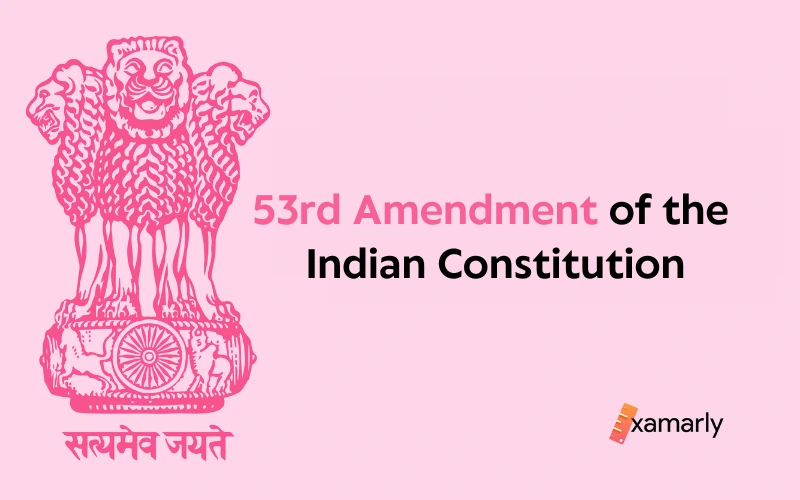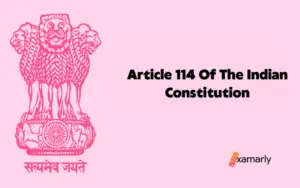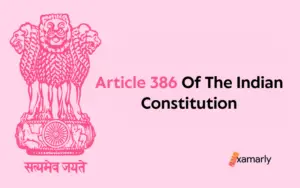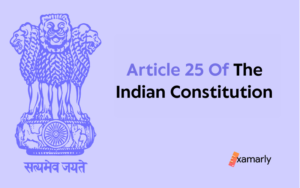The 53rd Amendment of the Indian Constitution is officially known as The Constitution (Fifty-Third Amendment), 1986.
This act holds the credit for the addition of Article 371G to the Indian Constitution. This was instrumental in the conferment of Statehood to the Union territory of Mizoram.
Read this article to gain a complete understanding of this constitutional amendment for the UPSC exam preparation.
- 53rd Amendment of the Indian Constitution: Shaping of Mizoram State
- Date enacted
- Statement of Objects and Reasons
- Prominent forces involved
- Important provisions
- Summing up
- FAQs about the 53rd Amendment of the Indian Constitution
- Which amendment of the Indian Constitution granted Statehood to Mizoram after the insertion of Article 371G?
- What does Article 371G say?
- What is the 53rd Constitutional Amendment about?
- Which bill was turned into the 53rd Amendment Act of the Indian Constitution?
- When was the 53rd Amendment of the Indian Constitution enacted?
- When was Mizoram declared a full-fledged State?
53rd Amendment of the Indian Constitution: Shaping of Mizoram State
Previously, under the Northeast Areas (Reorganization) Act, 1971, Mizoram had been declared a distinct Union territory in 1972. The region was known for instances of violent insurgency.
Signing an accord for establishing Mizo peace was the only way to reinstate peace and harmony in the State. The interests of the Mizo community had to be protected. This was achieved through the insertion of Article 371G into the Indian Constitution. This came to be known as The Constitution (Fifty-Third Amendment), 1986.
A treaty was finalized between the Union Government, State Government, and the Mizo National Front (MNF) on June 30, 1986. Following this, Mizoram attained its identity as the 23rd State of India in the year 1987.
Also Read: 52nd Amendment of the Indian Constitution
Date enacted
The 53rd Amendment was possible after the addition of Article 371G to the Indian Constitution. Eventually, the Fifty-Third Amendment Act came into enforcement on February 20, 1986.
The constitution amendment bill along with another one for the conferment of Statehood to Mizoram was introduced in the Lok Sabha.
Statement of Objects and Reasons
The Statement of Objects and Reasons is summarized below which were listed in Article 371G.
After Article 371F of the Indian Constitution, the former article was to be inserted. This article was in favour of a special provision with respect to the State of Mizoram. Notwithstanding anything in the Constitution, it prohibits certain Acts of Parliament in some respects.
Mizo customary law, procedure, and the social and religious practices of the Mizo community cannot be amended by any Act of Parliament. The transfer of land and its ownership is also included in the article.
The decisions that are to be taken by the Mizo customary law concerning the administration of civil and criminal justice are out of bounds for any Act of Parliament. The aforesaid matters are in complete control of the Legislative Assembly of the State of Mizoram. It can be applied to the State only after resolution by the above authority.
The article also mentions that before the commencement of the 53rd Amendment Act, 1986, nothing in the clause applies to any Central Act that has been enforced in the Union Territory of Mizoram.
In addition to this, the Legislative Assembly of the Mizoram State must constitute a fixed number of members. This number is specified in the article as at least forty members.
Prominent forces involved
The Government of India, the Government of Mizoram, and the Mizo National Front (MNF) came together to sign a tripartite peace treaty on June 30, 1986. It was known as the Memorandum of Settlement in Mizoram.
The motive behind doing so was to harbour peace and also to recognize the Union territory of Mizoram as a distinct State by other requests included in the memorandum.
Important provisions
Article 371G imparts special provisions to the State of Mizoram. It gives the State a special category status. It clarifies that no Acts of Parliament apply to the region unless the Legislative Assembly of the State decides so.
The Mizo customary law, procedure as well as religious or social practices are to be protected by the special status. The Mizo customary law must be abided by for the decisions that concern the administration of civil and criminal justice.
Lastly, the possession and passing of land shall apply to Mizoram unless the Legislative Assembly of the State decides so by a proposal.
You Might Also Like: 54th Amendment of the Indian Constitution
Summing up
Through this blog for UPSC preparation, you learnt that the 53rd Amendment Act was enforced on February 20, 1986. The amendment bill to confer Statehood to Mizoram was introduced on August 5, 1986, in the Lok Sabha. On February 20, 1987, the State of Mizoram was recognized as a full-fledged State.
Enforced in the thirty-seventh year of the Republic of India by the Parliament, the 53rd Amendment Act was a notable step toward restoring peace in Mizoram. It did so by the introduction of Article 371G to the Indian Constitution.
It was an important provision concerning the Mizo community to uphold and protect their rights and customs. There was an urgent need for a constitutional guarantee to ensure that the Mizo land or the religious beliefs of the people is not encroached upon.
Therefore, adequate administrative measures needed to be put in place.
FAQs about the 53rd Amendment of the Indian Constitution
Which amendment of the Indian Constitution granted Statehood to Mizoram after the insertion of Article 371G?
The 53rd Amendment, of 1986 granted Statehood to Mizoram by the insertion of Article 371G after Article 371F of the Constitution of India.
What does Article 371G say?
Article 371G is concerned with the special provision concerning the State of Mizoram, similar to the special category accorded to the States of Arunachal Pradesh, Andhra Pradesh, Goa, etc. under Article 371 of the Indian Constitution.
Firstly, rendering power for taking decisions to the Legislative Assembly of the State by limiting the authority of Acts of Parliament. No Act of Parliament could have any effect on the Mizo customary laws, procedures, religious, social practices, and administration matters related to civil and criminal justice.
Secondly, it mentioned that the Legislative Assembly of the Mizoram State should have a minimum of forty members.
What is the 53rd Constitutional Amendment about?
The Constitution (53rd Amendment) Act, 1986, added Article 371G to the Constitution of India. It aims to keep a check against unwanted interference by the Central Government.
The act protects the interests of the community conduct and social relationship laws that apply to the State of Mizoram.
Which bill was turned into the 53rd Amendment Act of the Indian Constitution?
The Constitution (Fifty-third Amendment) Bill, 1986 (Bill No. 88 of 1986).
When was the 53rd Amendment of the Indian Constitution enacted?
February 20, 1986.
When was Mizoram declared a full-fledged State?
February 20, 1987.






